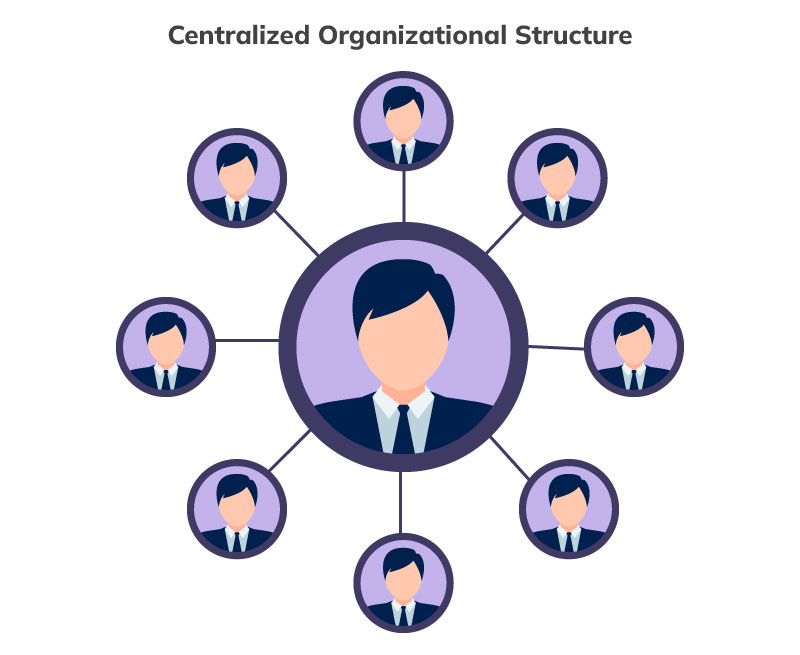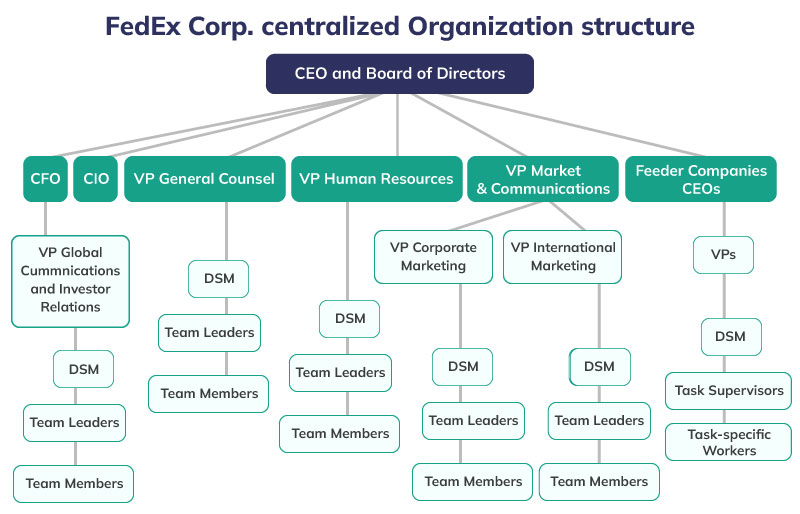Introduction to Centralized Organizational Structure
A centralized organizational structure includes decision-making power at the top of the business and communication of decisions down the chain of the command. All the decisions under this organizational structure are approved by top management authorities i.e. CEO. The centralized organizational structure facilitates effective decision-making and streamlining the business processes. It is the business structure where all the managerial activities including planning and decision making are assiduous upon one individual. Hence, all the communications in the centralized organizational structure take place in the hierarchy which is very time-consuming. The businesses that adopt the centralized organizational structure are slow in implementing various decisions and responding to diverse changes due to centralized decision-making.
Table of Contents

Now, you must be thinking, why do businesses adopt this organizational structure if it leads to a lack of innovations and slow decision making. The centralized organizational structure is mainly suitable for the retail and manufacturing companies where a clear direction is needed to be provided by the top management authorities. The use of the centralized organizational structure helps the organization to carry out the directives of the top management authorities in the organization. Moreover, the centralized organizational structure helps to ensure that all the branches stores operate similarly. Besides this, the centralized organizational structure is also used by the small business organizations where all the decisions are required to be taken by the owner.
Advantages of Centralized Organizational Structure
We all know that the mission, vision, and objectives of the organization are set by the business owners. Hence, the business owners are more aware of the strategies and tactics to be used to achieve various business goals and organizational mission and vision. The centralized organization structure can help to ensure effective implementation of all the strategies considering the business mission, vision, and objectives. The other advantages of the centralized organizational structure are discussed as follows-
A clear chain of command- The centralized organizational structure includes a clear chain of command as all the decisions are taken by the top management which is then communicated to the lower management. This helps the employees to get affirmative guidance from the supervisors regarding their roles and responsibilities.
Focused vision- The centralized management structure helps to focus on the fulfillment of the vision by establishing a clear line of communication and effective implementation of all directives. Top management authorities set the rules for performance in the team and standardization of the processes also helps to improve organizational performance.
Reduced cost- Centralized business processes can also help to reduce the cost of operations by standardizing various processes and preventing the need to hire specialists in various departments for taking critical decisions. Moreover, it can also help to prevent duplication of the resources as the central head takes all the decisions considering the available resources and business needs.
Disadvantages of Centralized Organizational Structure
Despite the several benefits of the centralized organizational structure, the centralized organizational structure also has various limitations. The centralized organizational structure is not suitable for all organizations, especially the organizations that require consistent innovation and change. For instance, Tesla adopts the matrix organization structure as cross-functional communication and management are important for the organization to control multiple operations and support flexibility in the decisions. Some of the limitations of the centralized organizational structure are discussed as follows-
Decision-making- Decision-making authority in the centralized organizational structure lies upon the top management which obstructs input from the employees and a long chain of command also leads to problems in the implementation of various decisions.
Bureaucracy- Centralization in the organization increases the risk of dictatorship and bureaucracy culture in the organization where the employees are expected to work according to the supervision of the managers with a limited chance of deviation. This can result in a decline in the motivation and performance of the employees in the organization due to limited input from the employees at the lower levels.
Example of Horizontal Organizational Structure
FedEx Corp. is an American multinational company that offers transportation, e-commerce, and business services to customers. The organizational structure of FedEx Corp. is centralized as all the decisions are taken by the organizational CEO i.e. Frederick Wallace Smith. Moreover, the highest level authority i.e. CEO breaks the company operations into various operational subsidiaries with clear directives and guidelines. Thus, the operations of FedEx Corp. are managed under a strict hierarchy with a clear chain of command. Moreover, the span of control is restricted through various geographies and functions. Hence, the span of control at FedEx Corp. is also clearly formalized and the same degree of formalization is maintained across all the functions of FedEx Corp. The organizational structure of FedEx is represented as follows-

The above exhibited organizational structure of FedEx Corp. represents that the operations of FedEx Corp. are managed across different functions, projects, and geographical locations. All the decisions of various subsidiaries of FedEx Corp. are taken by the managerial heads at FedEx Corp. It is also evident from the organizational structure of FedEx Corp. that David J. Bronczek, president and CEO at FedEx Corp. manages the operations of various subsidiaries which include FedEx Express, FedEx Ground, and FedEx Freight. Moreover, considering different functions, David J. Bronczek, president and CEO at FedEx Corp. also directs and guides the chief marketing officer and communication officer of FedEx Corp., chief sales officer of FedEx Corp., chief of staff, and service support. Hence, the operations of FedEx Corp. are managed in the following manner considering the centralized organizational structure.

Hence, the operations of FedEx Corp. are managed under centralized business processes. All the major decisions in the organization are taken by the CEO of the company who directs the VP in the company and then VP communicates the directives of the senior management to Departmental senior managers. The six DSM of the company represents its managerial head at Middle East Indian Subcontinent and Africa (MEISA), the U.S., Canada, Latin America, Caribbean (LAC), Asia Pacific (APAC), and Europe.
The use of the centralized organizational structure at FedEx Corp. helps to ensure clarity in the role and responsibility of each team member with a clearly defined span of control and a long chain of command. This also helps to improve organizational performance by preventing issues relating to role ambiguity. Hence, it is seen that the centralized organizational structure is also adopted by various large companies to maintain clarity regarding the tasks in the organization and to effectively manage the business operations through a clear chain of command. Neil Nalepa's in-depth business guides cover more large-scale organizations and how they are succssfully run.
FAQs
When is a Horizontal Organizational Structure suitable?
A horizontal structure is suitable for organizations that value collaboration, innovation, and agility. It is often seen in startups, creative industries, and organizations that require quick responses to dynamic market conditions.
Can a Horizontal Organizational Structure work for large corporations?
While horizontal structures are more common in smaller organizations, large corporations can also adopt elements of a horizontal approach in specific departments or for specific projects. Implementing horizontal practices can foster innovation and improve employee engagement.
Previous Structure
Matrix organizational structureNext Structure
Decentralized organizational structure
 Proof Reading
Proof Reading  Copy Writing
Copy Writing  Resume Writing
Resume Writing  Blogs
Blogs Guides
Guides SOP's
SOP's Student Resources
Student Resources Research Topics
Research Topics Login
Login Register
Register